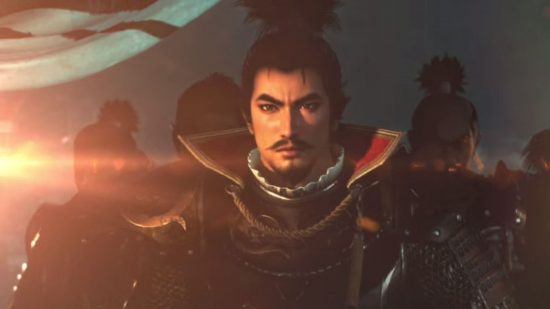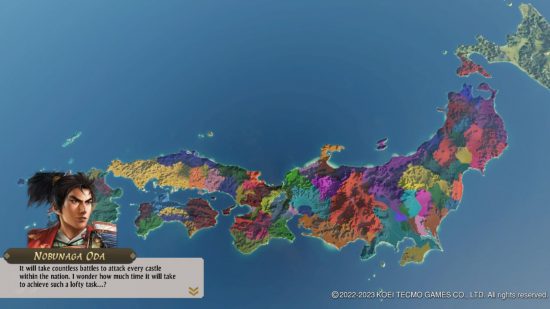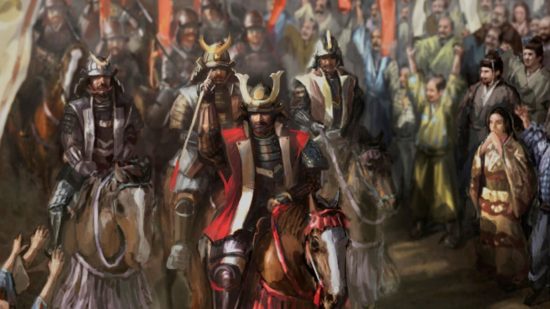Our Verdict
Nobunaga’s Ambition: Awakening continues a long and dependable series in the exact fashion you’d expect, but playing it on Switch is a clunky and unintuitive experience, bringing a charming sim into the territory of irritating micromanagement.
When we think about 4X simulations – the games whose primary verbs are, somewhat bluntly, ‘explore, expand, exploit, and exterminate’ – there are apparent storied franchises to discuss. Civilization VI is the grandaddy, Total War is a nice historical side track, and the recent Crusader Kings III is an absolute gem. But there’s another series that has been around longer than all of them.
Back in 1983, Koei made Nobunaga no Yabō, the first game in its genre of turn-based grand strategy, a genre that would evolve somewhat, gain different monikers, but largely owes its lineage to Koei’s first step. And now, 40 years later, the virtual reins of Nobunaga’s ambition to reunify Japan are still yours for the taking.
Nobunaga’s Ambition: Awakening is the sixteenth entry in this relatively ancient series, one that hews close to the Romance of the Three Kingdoms strategy games, and shares aesthetic similarities with Dynasty Warriors. It’s a nice little bucket of fantastical history that Koei produce, though if you’re hungry for more after enjoying a Warriors title, this game is likely not the best place to start.
That’s because Nobunaga’s Ambition: Awakening is dense. It is a game of micromanagement, full of oblique game mechanics that are thrown at you throughout the first hour with little tutorial text boxes that feel like they may never end. While it may not be the most thrilling way to get your teeth into this sort of game, it’s all pretty essential.
The game attempts to simplify this pile of confusion into three clear categories: Dominion, Politics, and Battle. The latter is pretty obvious – this involves mustering armies, assuring you have enough provisions for a march, and going to conquer other lands. Battles are simple number crunching; have more soldiers than the enemy and you will win. You can also flank and pincer enemies, though it’s no Total War.

Politics, meanwhile, plays out via a long list of various policies and dozens of different officers and retainers each with their own stats that affect various factors within domains and at the head of your clan. You can appoint people to look after a domain, ask them to assist in the development of policy, and appoint them to your council all with the aim of unifying Japan.
These different people also have a loyalty stat, which can affect their likelihood of staying by your side. Combine this with various traits that in turn affect the Battle and Dominion aspects of the game, and it’s a massively deep and intricate pile of numbers that it’s a bit of a nightmare to get your head around. The best way to do this is to play the game, and a lot, or to have already played a previous entry (alternatively, experience in Romance of the Three Kingdoms will help a lot too, they are reasonably similar games).
Politics doesn’t just mean wrangling people that are already on your side. There’s diplomacy, where you can make an alliance with a powerful neighbor, request reinforcements for a difficult battle, or try to make a truce with an enemy you have no chance of defeating. This again all plays out with maths, and various numbers affect your chance of success. Underneath all the kinda pretty graphics, this still feels like something written in BASIC in 1983.
And, finally, the third pillar is Dominion. This is luckily a little simpler; it involves constructing buildings to improve your castles and domains, appointing officers to look after areas, and generally keeping everything looked after at home. It’s only relatively simpler, however – there’s still a lot of things to keep in mind throughout.
So, that’s Nobunaga’s Ambition: Awakening, in terms of the fundamentals, at least. All of this shouldn’t sound unfamiliar to anyone who’s played this series before, but it should come as warning to any Civilization fans hoping for something a little different. This is a dense and knotty videogame, one that you can have lots of fun with once you break down the barrier to entry, but that barrier is rather high.
That’s not to say it’s difficult, however. It’s not the sort of game that punishes you harshly for getting something wrong. So, while any strategy aficionados may want to min-max the micromanagement, you can still have a reasonably easy ride getting into the swing of things without taking it all too seriously.
To liven things up slightly, Nobunaga’s Ambition: Awakening has various cutscenes that play out visual-novel-esque at certain points in the game. A famous daimyō may fall dead unexpectedly or an ambush may catch you by surprise, letting the game pay out a little bit of story. In terms of writing, they’re just fine, but there’s nothing super special here unless you know a bit of Japanese history – likely the biggest hurdle to localizing this game is the fact that certain big names are meaningless to a lot of folks.
Still, these little scenes are a nice change of pace, and they add an extra flavor to the game, of the sort you don’t really get in most other titles in this genre. Read up a bit on the main players involved before diving in, and you may be able to get invested in the various events that occur.
So, it all sounds like Nobunaga’s Ambition: Awakening is a neat little package, and it sort of is, on paper. The issue is, this game isn’t played on paper, this game is played on Nintendo Switch, at least for me. And it’s not a very comfortable home. It’s likely a much more charming proposition on PC.
The primary issue of Nobunaga’s Ambition: Awakening on Switch is visibility. In handheld mode, text is so unbearably tiny that anyone will have an issue reading it, while the movements of your various units or navigation over your domain can feel a little stodgy. Everything’s quite hard to see and read, and this takes a massive amount of shine off of the process of reunifying Japan.
Secondly, the controls are always a tad clunky. In any game like this, you’re going to have to navigate through a lot of menus, and doing so in Nobunaga’s Ambition: Awakening is a bit of a pain.

For example, you can push a trigger to open one radial menu and the Y button to open a different radial menu. These radial menu options then each have their own radial menu within, and reaching the desired screen just feels wonky and unintuitive.
Combine this with the fact that certain menus act like pop-up overlays, so you’re not always clear on what you’re navigating through with the right stick, and it’s quite a grating experience. The touchscreen controls help to manage this somewhat, but the menu options are all so tiny that it’s still not a fix.
All of this takes Nobunaga’s Ambition: Awakening down from a decent game to a pretty irritating game. There is so much to manage, and doing all of that has to be easy. It has to be able to become second nature. But it’s a real struggle to get there on Switch. If you want to give it a go, I’d recommend looking into the PC version, because it is an enjoyable sim. And if you really, absolutely have to have it on Switch (and you’re eyesight is fighter-pilot level), it’s passable. But overall, the game is really let down on Nintendo’s handheld.
For more grand strategy, check out our Civilization VI tier list, or our Total War: Medieval 2 mobile review to see what it’s like on the go.


